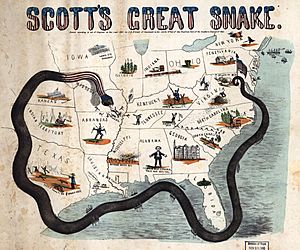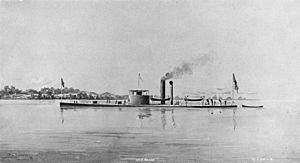Union Blockade facts for kids
Quick facts for kids Union Blockade |
|||||||
|---|---|---|---|---|---|---|---|
| Part of the American Civil War | |||||||
 A 1861 characterized map of the Union blockade, known as Winfield Scott's Anaconda Plan |
|||||||
|
|||||||
| Belligerents | |||||||
| Commanders and leaders | |||||||
The Union Blockade was a huge effort by the Union Navy during the American Civil War. From 1861 to 1865, the Union Navy tried to stop ships from entering or leaving ports in the Confederate States of America. This was a type of economic warfare. It meant they used their navy to hurt the South's economy.
The main goal was to prevent cotton, supplies, soldiers, and weapons from moving in or out of the Confederacy. Most ships from other countries respected the blockade. However, some special ships, called blockade runners, tried to sneak through.
Contents
What Was the Union Blockade?
The Union Blockade was a plan to cut off the Confederate states from the rest of the world. The Union Navy patrolled the Atlantic Ocean and the Gulf of Mexico. Their job was to stop trade and supplies for the South.
This was a very big job because the Confederate coastline was about 3,500 miles (5,600 km) long. It included many important ports.
Why Was the Blockade Important?
The blockade was a key part of the Union's strategy. It aimed to weaken the Confederacy by stopping their ability to sell cotton. Cotton was their main way to earn money from other countries. It also aimed to stop them from getting important supplies like weapons and medicine.
By cutting off trade, the Union hoped to make the South run out of resources. This would make it harder for them to continue fighting the war.
The Anaconda Plan
President Abraham Lincoln announced the blockade on April 19, 1861. This plan was part of a larger strategy called the Anaconda Plan. General Winfield Scott came up with this idea.
The Anaconda Plan aimed to "squeeze" the Confederacy. It was like a giant snake wrapping around its prey. The plan had two main parts:
- A naval blockade along the coast.
- Control of the Mississippi River to split the Confederacy in two.
Major Ports Blockaded
The Union Navy focused on blocking twelve major Confederate ports. These included:
- New Orleans, Louisiana
- Mobile, Alabama
- Charleston, South Carolina
- Savannah, Georgia
- Wilmington, North Carolina
New Orleans and Mobile were the top two ports for exporting cotton. Stopping trade there was a big blow to the South.
Blockade Runners
Even with the blockade, some ships tried to get through. These were called blockade runners. They were usually new, fast ships with not much space for cargo.
These ships were often built and paid for by British companies. They were also operated by British sailors, sometimes even Royal Navy officers on leave. They sailed between Confederate ports and neutral ports like Havana, Cuba, Nassau, Bahamas, and Bermuda. British suppliers had set up bases in these neutral ports.
How Successful Were Blockade Runners?
At the beginning of the war, it was fairly easy for blockade runners to get through. About five out of six attempts were successful. But as the war went on, the Union Navy got stronger. By 1864, only about half of the attempts were successful. This meant a blockade runner's average "life" was just one round trip.
Even when they succeeded, blockade runners could only carry a small amount of cargo. This was much less than regular trading ships.
Impact of the Blockade
The Union Blockade had a huge impact on the Confederacy. Before the war, the South exported about 10 million bales of cotton over three years. During the blockade, this dropped by 95% to only 500,000 bales.
The U.S. Navy built about 500 ships for the blockade. Over the course of the war, they captured or destroyed about 1,500 blockade runners. This greatly reduced the supplies and money reaching the Confederacy. The blockade played a big part in the Union's victory in the Civil War.
- Sources and further reading: Citizendium


